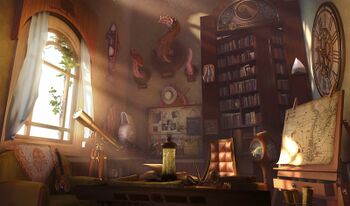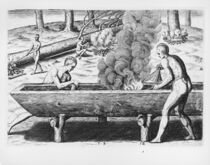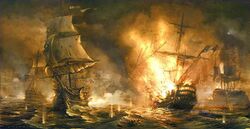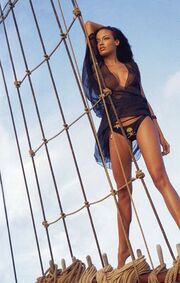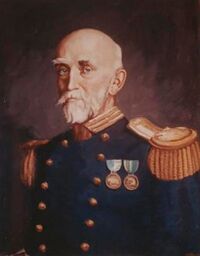Navalism
Navalism is the term used to describe the lifestyle, actions or dreams of groups or individuals with an obsession for ownership, command and control of a mighty flotilla of warships and associated paraphernalia. The Navalist is most satisfied upon opening his window onto Portsmouth Naval base during ‘morning colours’ to the flutter of flags, the chirp of bosun’s whistles and the smell of tar and varnish.
The interior of the typical Navalist’s house is adorned with brass speaking tubes, compass bowls and barometers. A tactical sea battle will be playing out on a navigational fathom chart in the corner, and a copy of the International Code of Signals will be open on the window sill, next to a leather-bound telescope, a bottle of Pussers Rum, a tin mug and a loudhailer.
However a good Navalist knows that his armada is nothing in port, and if the enemy arrive in the Western Approaches unchallenged, there’ll be the Devil to pay. The thought of a fighting flotilla in the heat of battle, with a Flag Officer at the head, Blighty astern and young powder monkeys executing gunnery drills below, is what the Navalist was born for.
History[edit]
The first navalist appeared in the Stone Age who decided a hollowed out tree was safer to travel in than a floating log. From him (or possibly her), the naval tradition started. Around 5000 years BC, a tribal navalist tried hoisting an animal hide on a thin tree trunk to capture the wind, transforming the vessel into a means of going from A to B rather than from A to the crabs and lobsters, then back to A again. It was a giant leap in naval technology. Now there was a sail and a mast and rigging, bits to point at, with special names that no one understood. The new sail boat charted the course for a new breed of navalist, the Naval Expert.
The first great Navalists were the Phoenicians who travelled around the Mediterranean uninvited for trade, colonisation and imposition. They were later followed by the Carthaginians and Greeks who took to naval exploration like ducks to water. The Romans were less keen on the aqua but like in all things, imitated the Greeks and improved on the formula with bigger ships and extensive slavery to man them. They also celebrated their victories by building a rostrum in the Roman forum composed to captured prows and mermaids. From there Roman orators like Cicero would orate for hours until closing time at the tavernas. This gave rise to the Great Naval Bore tradition.
Following the Romans in later centuries, the Byzantines and Vikings fought each other on the oceans and with the Arabs who became very adept at naval warfare. The Byzantines eventually came up with Greek Fire, a weapon that could set a sea on fire and all those who rowed into the vicinity.
The next great 'navalists' were the Italian city states of Genoa and Venice. In particular Venice, which had the added advantage of being located on a set of islands which meant to get to them, you had attack by sea. The Venetians (like the British after) considered they were 'married to the sea' and would each year have a lavish ceremony where vast quantities of home brew wine was poured into the sea as an offering to their continued success. This gave rise to the expression in Italy 'I am pissed as a Venetian fish' (Sto incazzato come un pesce veneziana)'. The fun eventually ended when Napoleon brought his cannons to the sea shore and started to bombard them till they surrendered.
Other nations like the Mongols and Chinese dabbled in Navalism but it didn't quite fit in with their traditions. The Chinese admiral Zheng He was a rare Chinese navalist and attempted to sail the world in his fleet of Chinese 'Junks' back in the 1420s - until he got the message to return home and make a new Ming vase. This left the Spanish and Portuguese to export their navalism by conquering the Americas.
As knowledge of the sea advanced, so did the language, culture and tools of the trade. Lengthy voyages meant for many, working on ships was a way of life. The experiences, songs and stories gave mariners an air of mystery and intrigue; as did their pony tails, gold earrings, tattoos of mermaids and scars across their backs. Even the diseases they brought ashore were exotic, like scurvy, rickets and chlamydia.
Sailor’s tales of derring-do and swashbuckling antics drove the imaginations of navalists throughout the modern world. Ruggedness and skills with a vast and unforgiving machine, verses Mother Nature and foe, with so much to gain and everything to lose, marked the quality of a nation's people. This symbolism was not lost among country leaders and it soon became such that if you were not a country of proud navalists, battling for supremacy upon the high seas, you were Luxembourg.
[edit]
To be a true navalist means much more than sitting on Plymouth Hoe, with a set of binoculars and a bored wife, chewing the fat over the difference between a ‘stretched’ type-42 and a type-42 that isn’t stretched (for budding navalists, the former is a bit longer than the latter). The true navalist must be a historian and a mastermind of strategy. He must be a tamer of the elements, an expert in finding routes by the stars and a natural master and commander. For a true navalist, a white beard is a must as well as being able to pick the bones out of every naval warfare tactical error since Ramesses' Battle of the Delta in 1175 BC.
Naval tactics were first mooted in 1690, when the British government mistakenly tasked Admiral the Earl of Torrington, with creating tactical fighting procedures to protect England from the far superior French fleet. Being a Royal Navy officer, not a navalist, he proposed treating naval warfare like taking a yacht to Guernsey for a long weekend, i.e. avoiding battle altogether unless the weather was favourable. During the next rather choppy westerly, the French invaded England by simply tying up at the passenger terminal in Dover port. Additionally, the new British naval tactics allowed the French to take complete control of the English Channel whenever it was raining, which was most of the time.
This allowed French privateers to interrupt Anglo-Dutch commerce, forcing the Admiralty to send warships to protect the merchant fleet. It marked a gradual shift to supporting the war on trade (guerre de course) instead of supporting the trade of ale (guerre sur la bière); even during a downpour. Historically, sea battles would commence with a collision and should both vessels be fortunate enough to remain afloat, cutlasses would be drawn and the last AB standing would win, getting a ‘bravo zulu’ (pat on the back) from the overseeing officers and double tot from the Killick. Navalists found this method of warfare distasteful and lacking any obvious form of seamanship. There was no 'holding the weather gauge', positioning for 'broadsides' or sufficient steely-eyed gunnery officers barking commands as the splinters were flying.
The progression of navalism ends at Naval Warfare; a navalist science, which, however the seafaring community may deplore the futility, is essential to the notability of a maritime nation,and those who represent her.
Gunnery[edit]
According to Navalists, the gunner 'is to see that they perform every part of the exercise with utmost correctness, strongly reinforcing the necessity of procedures, special terminology and shouting.' The following Navelist gunnery procedure would never reflect the more rapid procedure that would be required in the heat of battle, and bears no resemblance to firing a Sea Wolf missile, which is done with a computer mouse from the comfort of an air conditioned the ops room.
The first requirement is to calculate how many crew are required (or still alive) for each gun. This has been determined by the weight and type of gun divided by the weight and type of gunner, multiplied by the severity of scurvy the gun crew are presently suffering, graded from 1 to 10.
| Words of Command | Observations or actions taken |
|---|---|
| Take heed | Pay attention you land lubbers |
| Cast loose your guns | Cast off side tackles, breeching ropes and muzzle lashings |
| Take out the tampion | Snigger at tampion, then remove the cork stopper from the end of the gun |
| Take off the apron | Snigger again, then remove the lead apron that protects the vent |
| Unstop the touch hole, | Snigger, then remove wax plug from the vent |
| Handle the pricking wire | Laugh out loud, then after being shouted at further, take the powder horn in hand |
| Prime | Pour powder into pan and vent |
| Bruise the priming | Firm down powder with knuckle to prevent it blowing away |
| Cover the vent | Cover the vent (Navalists were unable make this action sound 'salty') |
| Handle your crows and handspikes | Attach levers to aim the gun |
| Take your match and blow it | Light a match |
| Fire | Bring match to the powder |
To comply with the requirement of the Health and Safety Executive to have a safety procedure, Navalists insist that the stop hole, or vent is to be closed with the thumb every time an item is passed into the muzzle. Although over the course of a single battle, the gunner will char-grill his digit, the action prevents hot embers being forced up through the vent and into the gunner's nose, causing one eye to close in a squint, affecting distance judgment.
Broadside firing at point blank (no elevation), within musket shot range of 200-300 feet, was the standard Navalist tactic however, to reduce the time it takes to turn both vessels into matchwood, often a midshipman would be cast adrift in a rowing skiff to act as a target. This allowed live firing 'at a mark' or more accurately 'at a Mark'.
Every Navalist knows that the tricky thing about tactical warfare at sea, is that it requires the enemy to be cooperative in terms of its positioning for the offensive maneuver to be effective, even after firing countless cannon balls at Mark. The small arc of fire requires that almost all multi-ship manoeuvres are based on both sides conforming to one of five 'Orders of Sailing'. Both sides rely heavily on strict discipline and tight station keeping on their guide vessel or the battle will quickly descend into chaos.
Procedures and terminology[edit]
Many linguistic adornings in use today stem from naval terminology kept alive by navalists, such as “combing the cat” (pet maintenance), "swing the cat" (Jazz music for Tiddles), “filibuster” (mixed grill at the local Parrot and Anchor) and “hasn't got a clue” (when the corner brass ring sewn into the fabric of a sail (clew) rips becoming foot loose, causing a foul-up and a potential jibe or two).
[edit]
Yacht owning is for the well 'keeled' and they are the ones who take 'navalism' seriously. They are the ones who kit out their ships with all the latest furnishings and rely totally on electronic gizmos to guide them at sea. So when everything goes down, it is these navalists who are ignorant of the sextant and plumb line and so end up lost at sea.
An important part of modern Navalism is the art of navigation, which without a GPS (which to a navalist would be considered cheating anyway), requires extended periods of quiet meditation over dusty nautical tables, clear skies, someone who can do maths and someone that could actually remember to wind the chronometer up every day or two. Read's Nautical Almanac opens with the reminder that: "So much greater must be the talents and more acute the ingenuity of a skipper, who can devise and execute an unscheduled anchorage in a region of peaceful, sun-kissed sub-tropical islands.
[edit]
First, lose the clothes. Oh...wait. See Nudism.
[edit]
Those who are the commander of the Seven Seas whilst groping for the bath plug. There are also what are called 'Weekend Nelsons', those who go to sea and sail out of harbour for a few hours before it gets dark. Not to be confused with people smugglers, drug runners or those adrift on a pedalo.
For trend-setters, Naval fashion is very popular with visitors to the South coast, especially at Brighton Yacht Club, as well as quay national events such as Royal Ascot. For the older generation, buttons, pips, caps and medal ribbons are the preferred attire. If taking a saunter along the promenade, a set of binoculars around the neck is also essential to the image, as is walking an old crotchety terrier called Nelson on an old piece of halyard.
[edit]
Kaiser Wilhelm was certainly a famous German Navalist. His home country Prussia had no tradition of building (or owning) a navy and had relied on Austrian navy to help beat the Danes in the 1864 war. The Kaiser started out with a rubber duck (painted in Prussian Blue) in the bath before progressing to owning a yacht and then ordering the cities of Germany to re-use their steel and sponsor a battleship when they ran out of famous Prussian generals to name them after. His 'navalism' was a reaction to what he saw as the British Navy's world domination and as a German (even his 'Brit' part was pure German too), he thought that intolerable.
Another modern Navalist was the American historian Alfred Thayer Mahan and his theory of sea power. This turbine charged naval man turned theorist was the re-founder the American naval tradition that had largely died out after the War of 1812. Mahan essentially said the Bigger the Navy, the Longer Stick. It was tradition later picked up the Imperial Japanese Navy who thought huge ships and enough long range guns to sink Manhattan were the answer. Unluckily for the Japanese, by sinking the USA's big gun fleet at Pearl Harbor the Americans became big Wingnuts instead.
Collectively the British have always been the biggest group of navalists. Why so? Consider. The centre of the world is Trafalgar Square in London and who is standing on his Freudian symbol in the middle?? Admiral Horatio Nelson. The British hero who died in victory and on The Victory. If the Duke of Wellington had died at the Battle of Waterloo he could have had that honour as it wasn't until 1844 that Trafalgar Square was built. So wedded to their navalism that Adolf Hitler intended to move the column (and Nelson) to Berlin as a trophy monument if Germany had won the Second World War.
